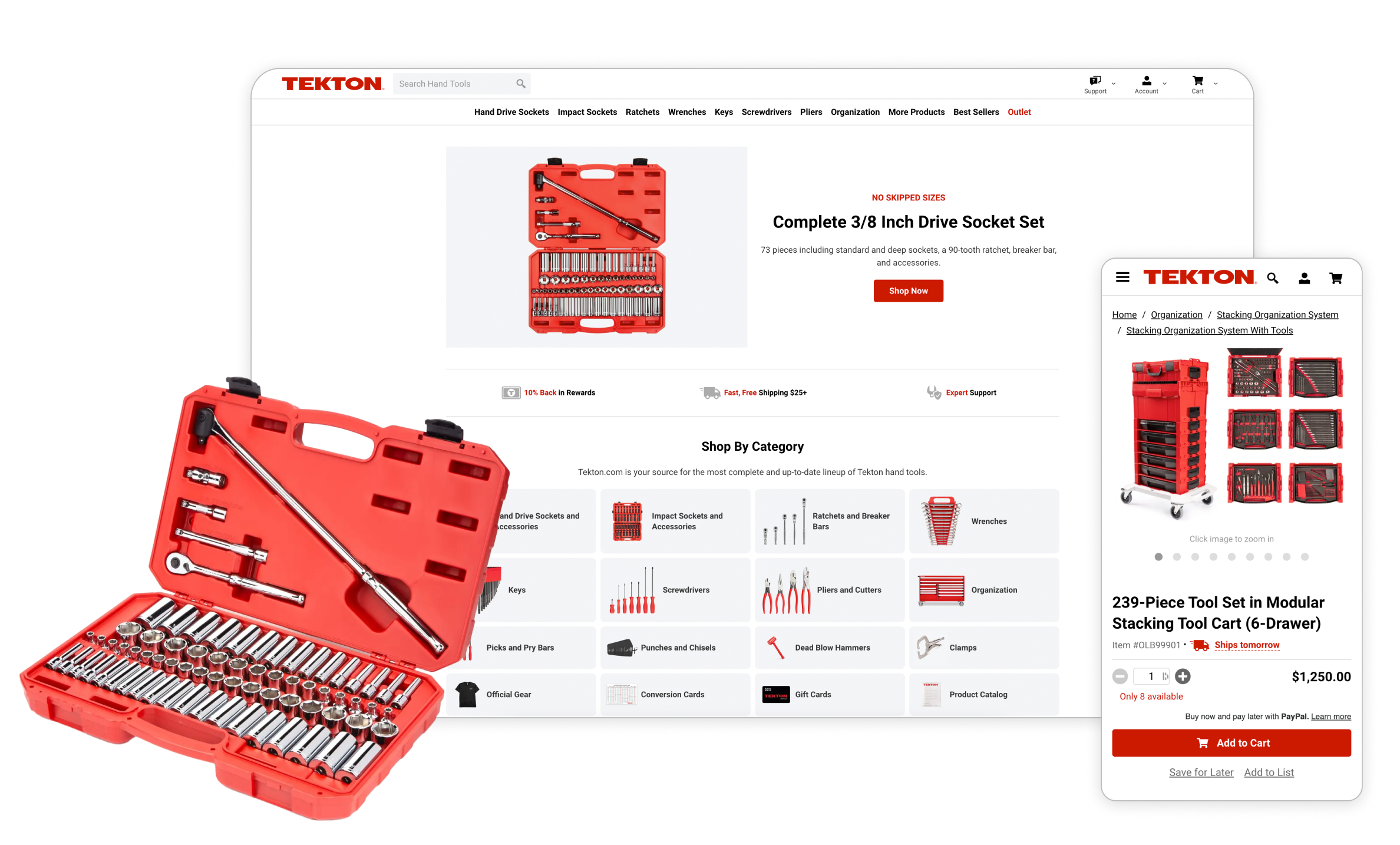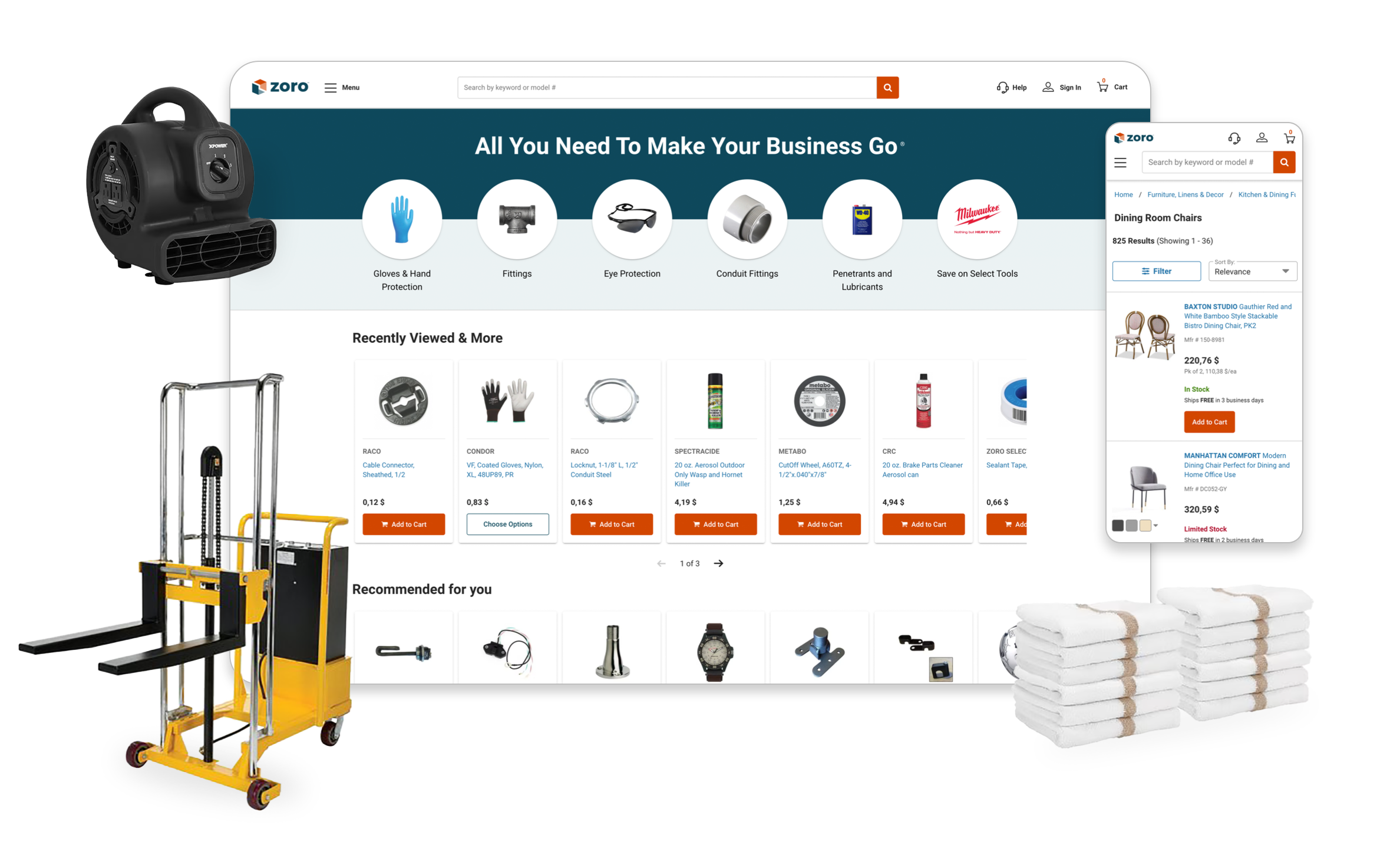Everything you need to know about B2B digital transformation and maturity.
eCommerce is the top revenue-generating channel among B2B enterprises. For manufacturers, distributors, and wholesalers, the time to invest in digital maturity is now. Get an overview and insights to support your digital transformation journey.

What’s B2B digital transformation?
Digital transformation is the process of modernizing digital technologies to streamline operations, scale automation and improve customer experiences. For the B2B sector, investing in digital transformation is a crucial step in staying competitive and meeting evolving buyer expectations.
While B2B organizations are traditionally less digital than brands and retailers, making purchases online has become an expectation of increasingly tech-savvy B2B buyers. Today, a strong eCommerce presence is a key priority for B2B players, so much so that 83% of B2B organizations plan to spend more money on digital starting in 2024. According to McKinsey, eCommerce generates more than one-third of revenue for B2B organizations.
These insights shed light on how crucial it is to invest in digital transformation — and to an extent, digital maturity — for manufacturers, wholesalers and distributors to thrive. For organizations beginning a digital transformation process, a composable commerce architecture is the go-to technology stack due to its inherent flexibility, agility and scalability.
Building a tech stack with a composable architecture provides the flexibility necessary to ensure that your digital tooling can adapt to the constantly changing needs of your organization, while also speeding up the time to get new functionality and products live on the site. Organizations need to think about digital tools as an investment, rather than a cost center.
What’s digital maturity in B2B commerce?
Digital maturity refers to the level at which a business effectively adopts and integrates digital technologies across its operations, customer interactions and decision-making processes. It goes beyond just using digital tools; it reflects how a company strategically leverages technology to drive growth, improve efficiency and stay competitive in a rapidly evolving market.
As digital maturity becomes essential in the B2B sector, organizations are at different stages of progress. Companies classified as “starters” are typically digital newcomers beginning their eCommerce initiatives. In contrast, those in the “advanced” stages are implementing customer-first digital strategies, supported by real-time data, flexible infrastructure and strong backing from C-suite executives.
Digital maturity investments are on the rise in the B2B sector*
*Source: Accelerating Your Digital Vision: Taking Your Strategy to the Next Level by Master B2B
How can B2B practitioners evaluate their organizations’ digital maturity?
The first B2B-specific digital maturity model, developed by commercetools in partnership with the experts at Master B2B, helps practitioners evaluate their organization’s digital maturity by assessing four dimensions:
Digital tools: How your organization leverages modern technology to streamline operations and improve the customer experience.
Team culture: How your company embraces digital from an organizational perspective.
Customer experience: Your company’s ability to meet buyer expectations.
Data and insights: How your organization makes clean, usable data available for business users to make data-driven decisions.

The 4 stages of B2B digital maturity, explained.
While there are four stages of digital maturity, the reality is that organizations may be in multiple stages for different dimensions simultaneously. This digital maturity model helps you identify your organization’s current position, making it easier to develop a clear roadmap for your digital transformation journey.
Your business is at Stage 1 when...
- You have executives who fear the challenges of digitization more than the opportunities it offers.
- You struggle to prioritize digital investments.
- You see data as a cost center rather than a driver of innovation and growth.
- You don’t offer online ordering or have a basic website with limited product selection.
Your business is at Stage 2 when...
- You’ve started looking for a digital expert from outside your organization to lead a small, growing team building your initial digital capabilities.
- You use a mix of legacy and modern systems in your tech stack.
- Your data is mostly siloed but increasingly viewed as a valuable asset for enhancing customer experiences.
- Your sales teams have embraced customers’ desire for an omnichannel buying experience.
Your business is at Stage 3 when...
- Large parts of your organization recognize their direct role in driving digital success.
- Your modern tech systems operate in real-time, with early steps toward AI adoption.
- Clean data enables broader distribution and more personalized customer engagement.
- Your customers enjoy consistent experiences across multiple channels.
Your business is at Stage 4 when...
- The CEO is driving and the C-Suite is executing on a customer-first digital strategy.
- Business users can leverage low/no code tooling and clean data without hassle.
- You’re running a flexible, scalable tech stack integrated with your systems of record.
- Real-time data powers advanced, personalized customer engagement and anticipates customer needs.
For MMG [Midmarket Growth] B2B digital commerce operations, a high level of digital maturity is a growth multiplier. The ability to experiment, iterate, and adapt to market fluctuations gives these firms a competitive edge.
What are the main obstacles B2B businesses face in digital transformation?
While investing in digital maturity has become increasingly important for the B2B sector, organizations must navigate several significant challenges related to digital transformation:
Resistance to change: Employees and executives may be reluctant to alter established processes and workflows, which can hinder the adoption of new technologies and strategies essential for modernization.
Legacy systems: Many businesses grapple with legacy systems that are often outdated and incompatible with new digital solutions, making integration complex and costly.
Skill gaps and talent acquisition: Organizations may struggle to find individuals with expertise in emerging technologies and digital practices.
Data security and privacy concerns: As companies digitize their operations, they must ensure robust protection for sensitive information to comply with regulations and maintain customer trust.
Budget constraints: Investing in the tools and resources necessary for successful digital transformation is critical, but limited resources force organizations to prioritize certain initiatives over others, potentially slowing their progress.
For your B2B organization to succeed in digital, a mix of technology modernization and organizational transformation is critical.
Rapid digital transformation is made possible with a combination of people, process and strategy. But, it's really a journey of continuous improvement. We're constantly innovating to meet and exceed customer expectations. When we launched our eCommerce solution, we primarily catered to existing customers. A lot of what we're looking at in the future is on the awareness and research side as we continue to scale and cater to new prospective customers.
Director of eCommerce, Cepheid (Danaher Group)

How can B2B organizations run a successful digital transformation journey?
Achieving digital maturity through a transformation journey presents many challenges for any B2B company. But there are six best practices that any business, regardless of their stage in digital maturity, can tap into, such as:
Evaluate your current level of digital maturity: Learn your organization’s status quo so you can better create a digital transformation roadmap that meets your needs.
Tackle data hygiene: When data isn’t clean, it’s impossible to get accurate product or customer information. This severely impacts your ability to create personalized customer experiences, provide real-time product inventory data, etc. Cleaning up your data — and finding ways to keep it clean over time — is a crucial step in your digital transformation.
Pursue organizational transformation: Digital transformation requires change management. Foster a digital culture, bring in digital enthusiasts and tackle hesitation head-on to win hearts and minds across your organization.
Address your customers’ urgent needs as the starting point: Identify what your customers consider top requirements and leverage quick wins, such as reordering capabilities, to drive an increase in orders and customer loyalty.
Tap into modern eCommerce technology: A composable commerce approach helps B2B organizations become digitally mature faster in a cost-effective way. According to IDC, “By embracing API-first composable commerce, which offers modular architecture for rapid innovation, MMG [midmarket growth] B2B firms can swiftly adapt to market changes to optimize revenue generation and capitalize on emerging CX opportunities.”
Implement at your own pace: Your business can get to market faster with an incremental rollout approach, an agile development framework, and the support of B2B-specific accelerators.
Tips to accelerate digital maturity for your business
- Use the digital maturity assessment by Master B2B to evaluate your stage across every dimension.
- Learn strategies and tips from seasoned B2B practitioners on how to move to the next level of digital maturity.
- Tap into best practices for a successful digital transformation.
What B2B organizations have successfully run a digital transformation process with composable commerce?
With composable commerce, you can embrace the latest technology from the get-go and leapfrog your competitors. This flexible and scalable approach enables you to start with eCommerce on your own terms, free from the constraints of all-in-one solutions or hard-to-maintain homegrown stacks. Importantly, you can avoid the pitfalls other companies have made during their transformation processes, which can help shape the strategy and roadmap of what works best for your company and its needs.
More than technology, a composable approach positively impacts your organization: Streamline workflows, boost internal collaboration and accelerate innovation. With the agility and adaptability of composable, B2B organizations are poised to stay ahead of buyers’ expectations, today and tomorrow.
Why do B2B businesses choose commercetools to accelerate their digital maturity?
There are top five reasons why B2B businesses choose commercetools for their digital transformation — and to improve digital maturity:
Composable and API-first architecture: commercetools provides an enterprise eCommerce platform with unparalleled flexibility to adapt quickly to market changes, implement new features at speed and integrate seamlessly with existing systems, such as ERP systems, through APIs.
Scalability and performance: B2B transactions often involve complex processes, large catalogs and high volumes of data. commercetools is designed to handle these demands efficiently, offering scalability that allows businesses to grow without sacrificing performance. This ensures a smooth and responsive user experience, even during peak traffic times.
Out-of-the-box features: With a suite of customizable and extensible out-of-the-box features, commercetools provides B2B businesses with core commerce capabilities for product catalog management, pricing and order processing, as well as a B2B-specific feature set, including buyer approval workflows and business unit-specific pricing and promotions.
Future-proofing: The continuous updates and enhancements by commercetools Platform mean companies can stay ahead of technological advancements and evolving customer expectations without needing to overhaul their entire system.
Fast implementations and time to value: Pre-composed solutions, like commercetools Foundry for B2B Manufacturing, provide a pre-configured set of components, features, best practices and launchpads, helping B2B businesses adopt composable commerce much easier and faster. Plus, the support of implementation partners and B2B-specific accelerators further expedites implementation timelines.
We moved to commercetools and built out our D2C site based on that. And it was a pretty natural extension to realize our B2B customers expect the same kind of experience that a D2C shopper wants. It’s been wonderful.
CMO, Tekton

How to start your digital transformation with commercetools?
The commercetools enterprise eCommerce product portfolio provides the essential elements to create a commerce solution that’s future-ready so you can evolve your digital footprint without limits. Our composable approach ensures your team can experiment and innovate at speed to meet the outstanding experiences your customers now expect from B2B purchasing journeys.
commercetools B2B Commerce
Adopt modern technology with a range of out-of-the-box features that are customizable and extensible, so you can tailor your eCommerce capabilities to your business needs.
LEARN MORE
commercetools Foundry for B2B Manufacturing
Leverage a blueprint designed to modernize eCommerce technology faster with pre-configured templates and best practices tailored specifically for B2B manufacturers.
LEARN MORE
Additional tools and services
Create storefronts that resonate with B2B buyers with developer and business tooling.
EXPLORERoll out your next-gen commerce with enhanced SLA, priority support and more.
EXPLOREAccelerate your time to value with technical onboarding, expert guidance and more.
EXPLORE








